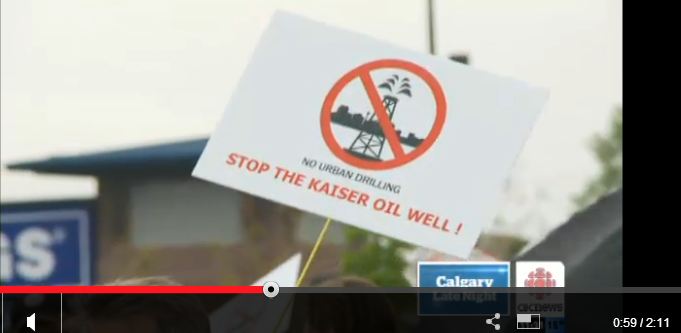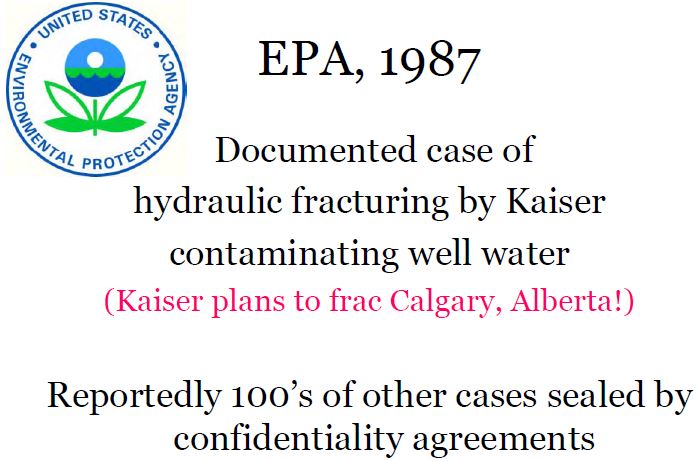
All courageously and firmly said “NO!” to frac’ing in the City of Lethbridge

The Power of “No” Review of presentation by Jessica Ernst in Lethbridge, Alberta

Even the Oil & Gas Capital of Canada, City of Calgary, said “NO!” to frac’ing!
Kaiser kills Calgary Royal Oak drill and frac for oil 400 metres from homes
National Household Survey: Calgary incomes highest in Canada

Royal Oak residents rally against oil well near homes

200 Rocky Ridge, Royal Oak residents rallied Sunday

Kaiser Oil Well to be frac’d in Calgary

Slides above from Ernst presentations
When no means no in mining Alberta’s treasured Eastern Slopes by Lorne Fitch and Kevin Van Tighem, March 27, 2021, Calgary Herald
When does no mean no? For most Albertans, it appears to be when a rookie government decides to open our Eastern Slopes for coal mining.
The Kenney government’s secretive agreement with Australian coal companies to revoke Alberta’s coal policy took Albertans by surprise. Then it was the government’s turn to be taken aback when Albertans of all stripes joined forces against coal exploration and new coal mines.
An apparently contrite energy minister finally promised public consultation over the issue, but she didn’t cancel massive new coal leases and destructive exploration programs. Although she said mountain-top strip mining would never be allowed in Alberta, government officials later clarified that only meant entire mountain tops wouldn’t be removed — slim comfort to Albertans concerned about land devastation and water pollution.
Secrecy continues to shroud that promise of “public consultation.” Will it be open and fair, or a contrived public relations exercise? How committed is the UCP government to seriously consider a “no mining” option? Distrust is rampant.
The Kenney government’s unfortunate history of failing to respect Albertans’ love of the Eastern Slopes dates back to an earlier decision, also done without consultation, to close parks and recreation areas. These are not trivial debates. The UCP seems to be promoting a fundamental shift away from protecting the scenery and ecological well-being of the Eastern Slopes, downstream water drinkers and a long-standing social contract by previous governments to care for our crowning jewels.
Consultation needs to take into account the cumulative effect of all the ways in which other interest groups already exploit the Eastern Slopes. Our mountains and foothills are reaching and have passed several ecological thresholds. It’s time to step back and restore some of the disturbance footprint, not add the lasting damage of coal strip mining to the mix.
Albertans treasure the Eastern Slopes. They are the source of almost all the water that our economy depends on. Those mountains and foothills offer natural diversity, beauty and recreational opportunity where many Alberta families seek refuge from cities, work and other stresses. Biologically unique, rare, magnificent and threatened species still survive there, although some, like native trout, hang on by a fin. The Eastern Slopes are an Alberta treasure.
All of that will change with coal mining. The evidence is unequivocal — one need only look over the border into the Elk Valley of B.C., or closer to home, into Alberta’s Coal Branch, to see the grimness of a future where those values are displaced by coal mining.
Coal lobbyists and their government enablers portray mining as a highly regulated industry. But the legacy of existing mines puts the lie to those earnest assurances about strict regulations, proven mitigation technologies and successful reclamation. Hype about jobs, royalties and taxes has little foundation; coal mining communities already have some of the most precarious boom-and-bust economies in the province.
Once our mountains and foothills are carved apart, the water fouled and depleted, gates installed to prevent Albertans from accessing our public lands, the trout gone and the campgrounds and communities coated with coal dust, it will be too late. There will be no second chance to protect our Eastern Slopes.
That’s why it’s now critical for Albertans to pay attention when Kenney’s government finally launches its coal consultation. We need to watch for trick questions designed to open a wedge for coal strip mining — questions like where mining could occur, how much disturbance is OK, or whether we support best-available mitigation technologies promised to solve the pollution problems. If we offer a qualified yes, coal boosters in government will hear the “yes” and take it from there.
If we cherish the Eastern Slopes, Albertans need to take this seriously.
The best answer to any question about stripping our Eastern Slopes for coal is a simple, blunt, unqualified “No.”
Because no means no.
![]() Bravo Mr. Fitch! Bravo Mr. Van Tighem! BRAVO ALBERTANS (But quit voting for lying racist abusive anti-environment super stupid bigots)!
Bravo Mr. Fitch! Bravo Mr. Van Tighem! BRAVO ALBERTANS (But quit voting for lying racist abusive anti-environment super stupid bigots)!![]()
Lorne Fitch is a professional biologist, a retired provincial Fish and Wildlife biologist and a former adjunct professor with the University of Calgary. Kevin Van Tighem is an Alberta landscape ecologist and author of several books on nature and conservation, including the newly released Wild Roses Are Worth It.
A few of the comments:
Mari Sali:
Water is a gift! Protect it! Respect it!
What Teck and other mining companies have learned is not to worry about Environment Canada’s “strict regulations” and that you can put a Band-Aid over it with water treatment.
UCP’s AER claims mining as a “highly regulated industry”.
But the legacy of existing mines puts the lie to those earnest assurances about strict regulations, proven mitigation technologies and successful reclamation.
Feldspar Irving:
Kenney doesn’t care about Alberta as long as China gets its coal from Australian corporations.
To paraphrase: ‘let them drink selenium…’
Daphne Veilleux:
No means No! The people of Alberta have spoken and you need to listen!
***
SYNERGY! STAY AWAY! The purpose of Synergy is to propagandize, exhaust and stamp out every “NO!” until a unified yes is reached, one that only profits industry and its enablers. Here’s how to hold sensible consultations on resource development by Gerry Kruk, March 27, 2021, Calgary Herald



In considering how to structure the public consultations on coal development in the Eastern Slopes, it is worth remembering the “due process” lessons learned by Alberta’s fossil fuel sector in co-operation with affected communities.
Industry has demonstrated path-breaking innovation on both the technological challenges facing development projects and on the complex issue of consultation and dispute resolution ![]() which comes with a mandatory gag order for any impacted and or concerned citizens conned into participating, and only benefits AER, industry and their enablers. If dispute resolution was fair, honest, honourable and appropriate, there would be no need to gag the harmed before they begin.
which comes with a mandatory gag order for any impacted and or concerned citizens conned into participating, and only benefits AER, industry and their enablers. If dispute resolution was fair, honest, honourable and appropriate, there would be no need to gag the harmed before they begin.![]() with concerned stakeholders. In short, Albertans have demonstrated leadership skills in the engineering of community consensus as well as in the engineering of pig iron.
with concerned stakeholders. In short, Albertans have demonstrated leadership skills in the engineering of community consensus as well as in the engineering of pig iron.
One compelling example is the meaningful stakeholder involvement in project planning provided through the Northeast Calgary Application Consultation Committee of 1991-1992. This was an eight-month process undertaken by community representatives in the northeast Calgary region concerned about the health and safety risks of a long-opposed plan by Canadian Occidental Petroleum to drill additional poisonous sour gas wells to expedite the depletion of the nearby Crossfield reservoir.
The parallels between this sour gas controversy and the current dissension over coal mining are numerous, rendering the committee experience relevant to present challenges. Both controversies involve emotive risk concerns; both are fuelled by widespread public distrust of both the developers and regulators; both involve large impact areas with many stakeholders, and both controversies are exacerbated by assumed frightening analogies — mountain top obliteration by coal miners in West Virginia and for the committee, the memorable Lodgepole sour gas blowout. In addition, dispute resolution in both cases seems unlikely because of the firm belief by many that the proposed development was simply “wrong in principle” and “morally unacceptable.”
These common challenges render the Northeast Calgary Application Consultation Committee process a useful case study today. First, its structural factors:
- Committee membership was open to all affected Calgary-area communities; no group was excluded because of its views on the project. Eighteen communities selected volunteers to represent them. Typically these representatives were strongly opposed to the drilling.
- In reviewing CanOxy’s proposal, residents were able to obtain assistance from resource people from government agencies, including the petroleum regulator, the City of Calgary, Calgary Health, Calgary fire department and Alberta Environment. Typically, the residents considered scientific studies they previously dismissed.
- While the 25-person committee plenary met monthly, four subcommittees were formed and met bi-weekly, each chaired by a community representative.
- An independent facilitator chaired committee plenary meetings and attended subcommittee meetings, providing valuable guidance on technical and procedural matters.
- When requested by the residents, funding was also provided for independent experts.
- To foster a productive working atmosphere of candid straight-talk and co-operative problem solving, committee meetings were closed to the media, elected officials and legal counsel.
The procedures used by the committee to ensure meaningful community involvement were also pivotal to its success:
- To build trust, communities participated in the project design process and shared control over risk-management decisions.
- Community representatives controlled the committee process — the issue agenda, procedures, timetable and recommendations. Government and CanOxy representatives only served as resource people to answer community questions.
- There was no effort to force an artificial unanimity. Decisions evolved through study and discussion rather than votes.
- Areas of disagreement and consensus were documented. To ensure accountability, community-approved minutes were kept of all meetings.
- The community representatives reported on and discussed the committee proceedings with their community associations, ensuring accountability and credibility.
Alberta’s Northeast Calgary Application Consultation Committee illustrated the benefit of elevating traditional “what do you think of our project?” consultation into a process of multi-stakeholder involvement and joint planning. Such an approach has a unique value. It combines the scientific rigour of environmental impact/risk assessments and the economic rationality of cost-benefit analysis with the procedural fairness of quasi-judicial hearings and the democratic principles of public participation. Through an inclusive, focused and sustained involvement process like the committee, stakeholder concerns can be better addressed, mutual understanding and trust earned, and informed compromise solutions forged.
In this case, the process resulted in the communities abandoning their previous opposition to the development. It recommended to the Energy Resources Conservation Board that: “On the condition that certain stringent recommendations are accepted and implemented … additional sour gas development in the NE Calgary study area could proceed.”
Gerry Kruk is a Calgary-based consultant whose career has focused on the use of stakeholder involvement and risk communications strategies to address project-related environmental and risk concerns of affected communities. He was secretary to the Northeast Calgary Application Consultation Committee.


